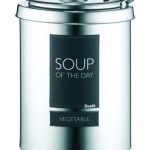

The Right Way to Use a Soup Kettle
The word ‘kettle’ might be more associated with something to boil water for a cup of tea or coffee these days, but soup kettles are not only a very different piece of equipment. For some kitchens, they're every bit as important.
The ‘kettle’ might also be known as a soup ‘warmer', which describes what it does, or a soup ‘pot', which alludes to its shape. Essentially, it’s an urn that holds anywhere between six and twelve litres and keeps liquids (not always soup) warm.
How It Works
The design is very simple and follows the bainmarie style of heating water in the machine. Water is poured into a cavity between the external wall and inner container to heat the food or drink to be kept warm.
Business Use
Commercial kitchens will generally find their soup kettles need to be at least 10 litres in size to maximise efficiency on energy by allowing the kitchen to provide hot soup all day without having to run a ring on the hob, which is costly. Not using the burner to heat soup also means that it is free to cook or heat something else. Assuming a serving is roughly 300ml, the 10-litre model will yield 33 servings. Of course, if you want to serve something else, adjust your servings accordingly. Mulled wine is a great example of another use for a soup kettle but something that might warrant smaller portions, which obviously means a higher number. What you will use the urn for most frequently will help determine the size and style you need.
Versatility
All good commercial kitchens will likely have a soup kettle, though they’ll also be found in many domestic kitchens, too. If you’ve ever had to cater for a village fete or a small-scale fundraiser, your soup kettle will most likely have come in very handy. They are lightweight and therefore easily portable, and they tend to be very robust and tolerant pieces of equipment. Look after it and it will be smart enough to be used in the kitchen or on display front of house.
As you might expect, the soup kettle will have an integral thermostat to allow you to control the temperature of the liquid within so that it doesn’t get too hot or cool down too far.
Be imaginative! Could you keep something else warm in the kettle? Gravy, maybe, or some other sauce. The pot can warm liquid food or drink, though not enough to cook it. Of course, especially if you are using the kettle for commercial purposes, make sure you are following all food safety guidelines. There is such a demand for these pots now that they are available in a wider range of styles and finishes, so you can match yours to the personality of your kitchen or restaurant. If you need help choosing, there are lots of specialist retailers who would be able to offer advice. Once you have one, we're confident you won't look back.


Validate your login
Login
Create New Account